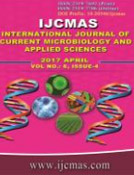


 National Academy of Agricultural Sciences (NAAS)
National Academy of Agricultural Sciences (NAAS)

|
PRINT ISSN : 2319-7692
Online ISSN : 2319-7706 Issues : 12 per year Publisher : Excellent Publishers Email : editorijcmas@gmail.com / submit@ijcmas.com Editor-in-chief: Dr.M.Prakash Index Copernicus ICV 2018: 95.39 NAAS RATING 2020: 5.38 |
Heavy metals severely affect the quality of water. Species of Salvinia are regarded as potent hyperaccumulators of heavy metals. Biotechnology will play a promising role in the development of new hyper accumulators by transferring metal hyper accumulating genes from low biomass wild species to the higher biomass producing cultivated species. Heavy metal toxicity and the danger of their bioaccumulation in the food chain represent major environmental and health problems. A very promising, environmental-friendly and cost effective alternative is plant based Biological control of heavy metal pollutants. Salvinia molesta holds a distinct position because of high productivity and tolerance to a wide range of temperatures. In the present investigation Biological control of Lead and Mercury contaminants of water by S. molesta was studied. The results showed that Salvinia molesta was able remove both Lead and Mercury from the polluted water. The percentage reduction in Lead and Mercury concentrations in the experimental water varied greatly at different concentration of both contaminants in the two aquaria used. It was found that at some points in the experiment involving mixed concentration of iron and chromium, there were preferences on accumulation of metals by Salvinia molesta. Lead was initially more accumulated by Salvinia molesta (up to 85%). As the concentration of contaminants increased, at high concentrations, Mercury was recorded to have been accumulated more in Salvinia molesta (up to 74%).
 |
 |
 |
 |
 |